This is nothing new. The griping has been going on for quite some time. My perspective is:
If you don’t want to hear other people’s opinions, don’t engage in a hobby that requires a microphone.
Of course, much of the contention is around those who don’t actually use a microphone in a VHF contest, or a telegraph key for that matter. Instead they use FT8 and MSK144 from the WSJT-X software suite.
Throwing My Toys Away
For my part, I’ve been reading these screeds and noting that the loudest objections were saying “do as I want you to do to provide the type of contesting I enjoy.” The very best followed up by saying they were going to sell all their VHF equipment and do something else. Oh no! Throwing their toys out of the pram!
Many, many others launched into a series of proposed changes. Few if any of these proposals adequately defined the problem they were trying to solve. Nor did they seek to seriously review what got us here in the first place.
Some Facts via K1JT
There was one voice that appeared to me at least to review the relatively recent past in VHF contesting. I quote this message from the Packrats email reflector:
I’m happy to see some real discussion about the effect of FT8 (and
other digital modes) on VHF+ contests, Roving, and other types of VHF+
activity. Such discussion, and planning for future events, is good.
I don’t have much new to say on the subjects under discussion, but it
might be useful to summarize a few facts that have been known for a long
time.
-
- Contests evolve over time.
- In the early years of this century it was possible for big stations
in or near FN20 to work 500 – 700 QSOs on either 50 or 144 MHz (or both)
in the January VHF SS. - By around 2007 the best 6m and 2m numbers were in the 400-500 QSO range.
- By 2011 and up to the present, the best 6m and 2m totals are in the
300’s. - None of this decline had anything to do with FSK441, JT65, MSK144,
FT8, or any other digital mode. The first three of these modes have
been interesting oddities in VHF contests, starting 2001, but have never
been major players in these events. FT8 was born in July 2017. - Yes, in recent years I have reported here several times that I worked
XXX stations in YYY sections, all (or nearly all) using digital modes.
I do this because I enjoy it. - I have never recommended that anyone else should operate VHF contests
in any particular way. FT8 and other digital modes in WSJT-X are freely
offered tools for weak-signal hamming. They are very good at some
things, not so good for others. Obviously, every operator should do
what he or she likes best, in contests and otherwise.
— 73, Joe, K1JT
PS, while I think of it.
I should have mentioned that in this mid-Atlantic region, at least,
since around 2000 the available contest QSOs on 222 MHz and higher have
decreased in a similar way to the totals on 6 and 2 meters. Once again,
the decrease had nothing to do with digital modes. In particular, it
came long before the advent of FT8.
One More Relevant Voice
There was another comment, this one from George, K5TR, on the VHF Contesting reflector:
In addition to the VHF contesting I do, I do a lot of HF contests. I choose not to do any digital contests. I have never found them to be very interesting to me. I enjoy the challenge of using my ears and brain to copy CW and voice signals. I have spent a large portion of my life now learning how to do this pretty well. Letting some machine do that for me removes the skill that I have worked so hard acquire. As a result I do not find the digital modes to be that much fun.
I appreciate George’s honest assessment of what he likes to do, what VHF contesting has become, and in the rest of his message considering what he’ll be doing in the future.
I also really appreciate K1JT’s assessment of the current situation in VHF Contesting. But George’s message finally hit home with me.
I can clearly understand that he has spent considerable time and effort, not to mention 48-hours in front of a radio on many weekends, honing his ability to decipher phone and CW messages.
Not only that, but he was honest enough to present his preferences rather than, as many are doing, claim that any number of factors should be considered over using digital modes in VHF contests. It really does boil down to personal preferences in all we do in our amateur radio hobby.
My Own Thoughts and Preferences
George helped me reflect more fully on my own preferences.
I really like digital modes. Copying CW has always been a challenge and voice messages tiring. If I look at the contests I’ve entered over the years, RTTY stands out as well as some of the newer FT8/FT4 contests.
I started operating RTTY back in the heavy metal days of the 1970s and 1980s with Model 15 and 19 Teletype equipment along with a homebrew decoder including a UART for changing receive speed as needed. I hadn’t really discovered contests at that time. But I did enjoy the QSOs, some DXing, and sending a few RTTY pictures.
Essentially what I enjoyed was building the equipment, figuring out how to get it to actually work, make a few QSOs to prove that I got it right, and then move on to the next thing.
More recently, I’ve enjoyed contesting as it helped me gain new DXCC countries or VUCC grids. Then the fun of starting from zero each contest and working my way through QSOs attracted me. What is also engaging for me is improving my station from one contest to the next.
You can find a number of blog posts here about my more recent RTTY contesting efforts. Then, I guess, I essentially tapped out all the enjoyment there and moved on to VHF contesting. That’s what happens.
As K1JT says: contests evolve over time. And what K5ND says: my ham radio activities evolve over time. Moreover, I don’t feel the need to make others conform to my wishes so that my preferred contesting activities remain relevant.
Good luck with your own ham radio activities. Find some fun. Gripe if you must.
Update 14-February-2021
Here are a few charts on the ARRL January VHF Contest. The data comes from James Duffey, KK6MC, and his ARRL 2020 January VHF Contest Full Results article. It’s specifically from his Table 1 on page 14 and Table 2 on page 15.
As a reference point, FT8 was introduced in 2017 and would have only come into use in the January contest in 2018.
As a further data point the number of logs received for the 2021 contest is currently shown at 1,196. That’s a 27% increase from 2020.
Update 26-February-2021
Well I guess I can’t stay away from this topic. I’ve dug into the numbers for the ARRL September VHF Contest and produced a few charts. These charts cover 2017 to 2020. So they don’t go as far back at the January numbers above. But they tell the same story. You can find the original report at ARRL September VHF Contest 2020 Full Results.


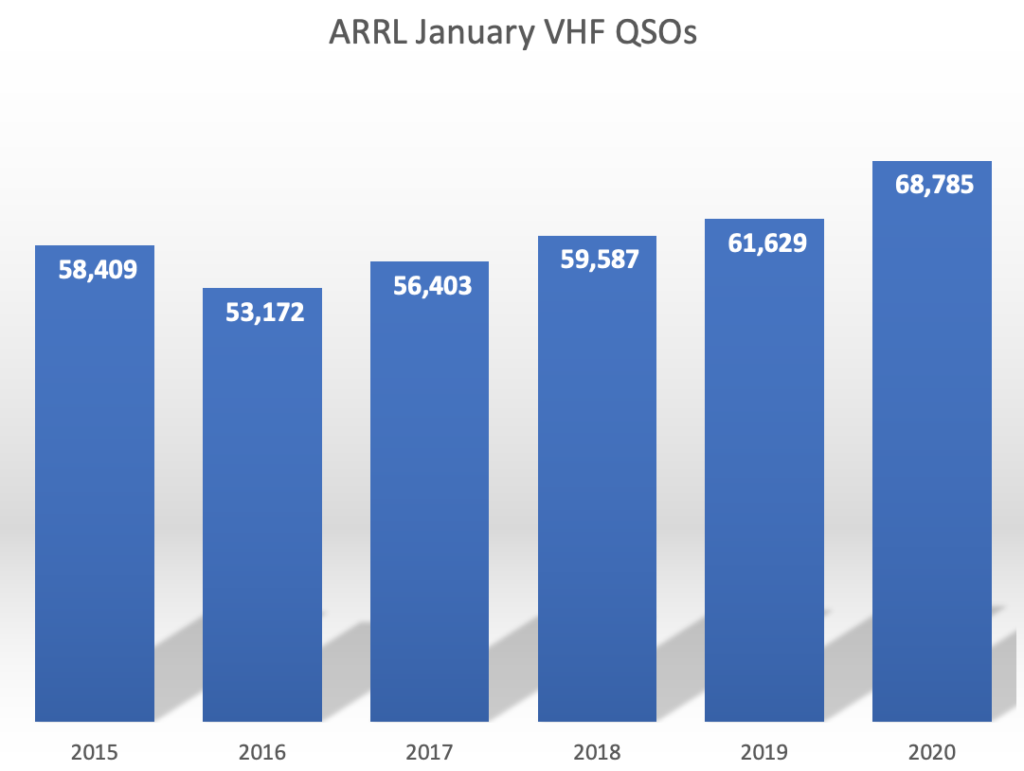
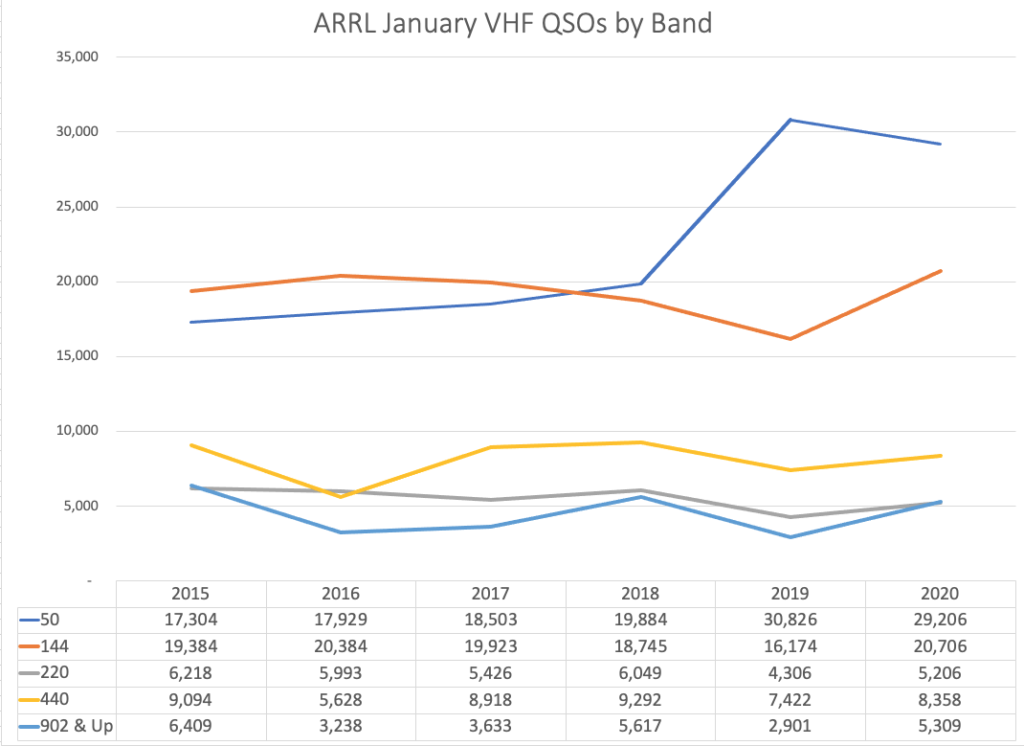
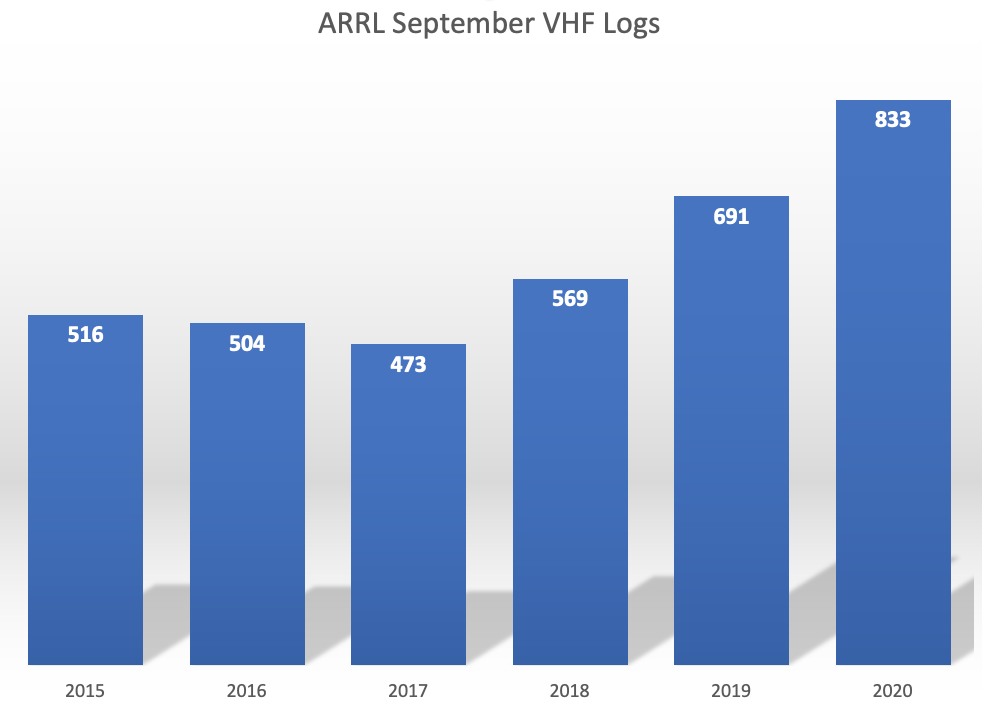

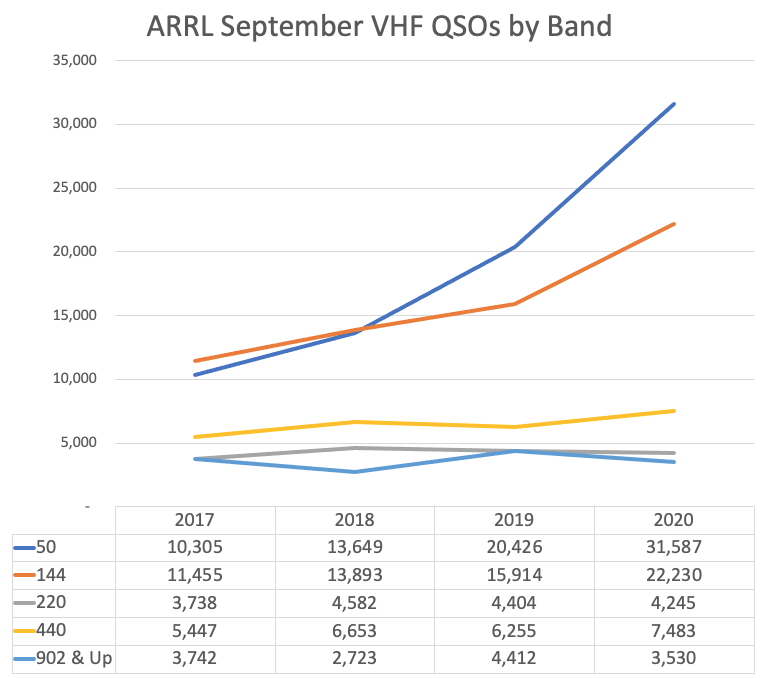
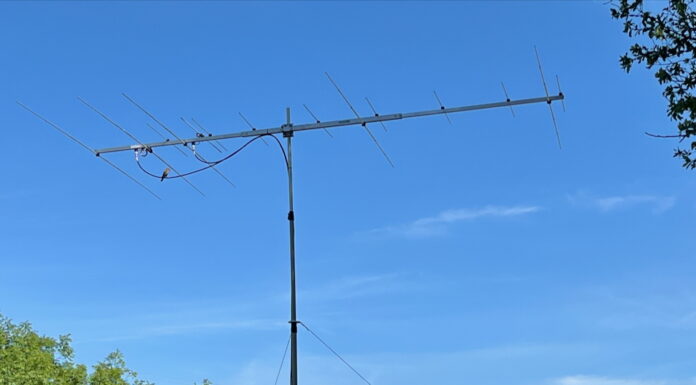







I respect your opinion, Jim, but I think you’ve missed a key point.
ARRL’s VHF/UHF contests have significantly withered starting with the onset of FT8 in these events (this is by far more of an issue with FT8 than any other mode). This is not an evolutionary change–it is actively driving activity down. QSO totals–meaning, what’s possible (look at K5TR’s June VHF contest results as a strong data point, prior to and since 2017) have taken a nosedive. It’s not because 6 meters suddenly decided not to open, either.
It simply does not matter what’s possible for small stations to do with FT8 if people are walking away from these contests because the experience is so poor for them. The QSO rates are dramatically lower and there is no human interaction. As you well know, RTTY also far exceeds the operator experience of FT8. Humans communicating with humans is the most engaging form of radio and it creates a broad draw.
The issue here in my mind is not so much ruining the contest for anyone in particular, though I have my own strong experience points on that topic also. It has far more to do with encouraging more overall activity, for the very future of our spectrum allocations.
Contest rules must be structured in such a way that they encourage more people to be active–more QSOs to be made. In particular on the VHF-UHF-SHF bands, we are under great pressure from commercial interests. Activity on a single SSB channel is not going to save these bands.
We are cooked if we can’d demonstrate better spectrum utilization than that. We must do better.
Some may say that we are going to lose these bands anyway, but shame on us–and what a profound loss to all future generations of Amateur Radio operators–if it happens because we didn’t pay attention to and try to prevent that loss.
Contest rules must encourage more activity and more spectrum utilization. They must create a draw, not a deterrent. The impacts of contest rules that encourage people to operate SSB and CW in addition to, or instead of, FT8 would include better spectrum defense, and also make these contests a lot more fun than a single-channel digital mode-fest with no alternative for those who cannot, or do not want to use, FT8.
–73, Rus, K2UA
Thanks for your thoughtful comments, Rus. All the best to you in your efforts to change VHF contest rules to encourage far more participation.
73, Jim, K5ND